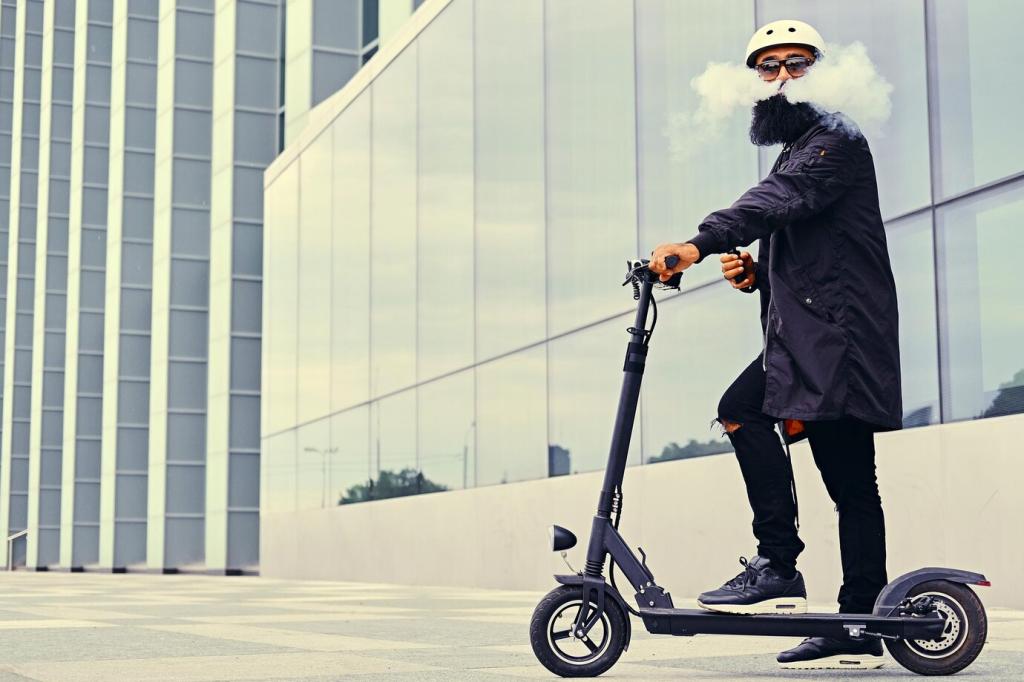
Battery Maintenance for Electric Scooters: Your Everyday Guide
Chosen theme: Battery Maintenance for Electric Scooters. Keep your rides smooth, safe, and longer-lasting with practical, real-world tips, friendly stories, and proven habits that protect your battery day after day. Subscribe for weekly insights and share your own routines so our community can learn from your experience.
Know Your Battery: The Basics Behind the Ride
Your scooter relies on lithium‑ion cells managed by a Battery Management System that balances charge, limits current, and prevents dangerous extremes. Typical packs last hundreds of cycles, but lifespan hinges on temperature, depth of discharge, charging habits, and storage. Comment with your model and cycle count to compare notes with other riders.
Know Your Battery: The Basics Behind the Ride
Capacity is your fuel tank; voltage reflects how full it is; state of charge is the percentage gauge. Expect voltage sag under heavy acceleration and recovery when resting. Monitoring these signals helps you avoid pushing the pack to damaging lows. Share your favorite app for tracking data and what numbers you watch most.




Smart Charging: Habits That Extend Battery Life
Keeping daily charges between roughly twenty and eighty percent reduces stress on lithium‑ion chemistry, slowing wear without sacrificing convenience. Full charges are fine for long trips, but avoid sitting at one hundred percent for days. Do you use charge timers or smart plugs? Share your setup to inspire fellow riders.
Smart Charging: Habits That Extend Battery Life
Stick with the original charger or a manufacturer‑approved unit to protect cells and the BMS. Slow, steady charging is gentler than constant fast top‑ups. If overnight charging, place the charger on a nonflammable surface with good airflow. Post your safe charging checklist so newcomers can follow along.
Storage and Seasons: Keeping Capacity Year‑Round
If you will not ride for weeks, store the battery around forty to sixty percent state of charge in a cool, dry place. Avoid leaving it full or empty for long periods. Mark a monthly reminder to check levels and top up gently. Share your storage routine so others can build theirs.
Ride Smarter: Daily Behaviors That Save Energy
Hard launches dump current, spike heat, and stress cells. Roll on smoothly, look ahead, and use momentum through gentle turns. Anticipating stops means less braking and fewer surge demands. Try a week of smoother riding and report your range change; even five percent is a big win over time.
Subtle Symptoms: Range Drop, Heat, and Voltage Sag
A sudden range decline, unusual warmth during easy rides, or exaggerated voltage sag under light load can indicate imbalance or a failing cell group. Log incidents and conditions to spot patterns. Have you noticed a change after a rough pothole hit? Tell the community what happened next.
BMS Cutoffs, Error Codes, and Safe Resets
Unexpected shutdowns often signal protective BMS action against overcurrent, overdischarge, or temperature extremes. Let the pack rest, inspect connectors, and review the manual for error codes before attempting resets. Share which codes your model shows and how you resolved them, so others can learn safely.
When to Consult a Professional
Swelling, chemical smells, scorched connectors, or repeated shutdowns demand expert inspection. Do not open sealed packs unless certified; it risks fire and voids warranties. Ask your dealer about diagnostics and official replacement options. Post your repair timeline and what finally fixed the issue to guide others.

Safety, Longevity, and Replacement Planning
Heat Is the Enemy: Keep It Cool
High temperatures accelerate chemical aging and can damage cells permanently. Park in the shade, avoid black car trunks, and let the pack cool before charging. If your commute is scorching, consider earlier rides. Invite readers to share cooling hacks that kept their scooters happy in summer.
Water Resistance and Post‑Ride Care
Know your scooter’s IP rating and its limits. After wet rides, dry the deck, ports, and brakes, then store indoors to prevent lingering moisture. Avoid charging immediately after heavy rain. Tell us how your model handles storms and what protective gear or covers actually worked.
Planning for End‑of‑Life and Recycling
Most packs deliver hundreds to a thousand cycles before noticeable decline. Track performance so replacement isn’t a surprise, budget for a new pack, and recycle responsibly via certified programs. Share local recycling options or a positive experience with a take‑back service to help others do the right thing.
